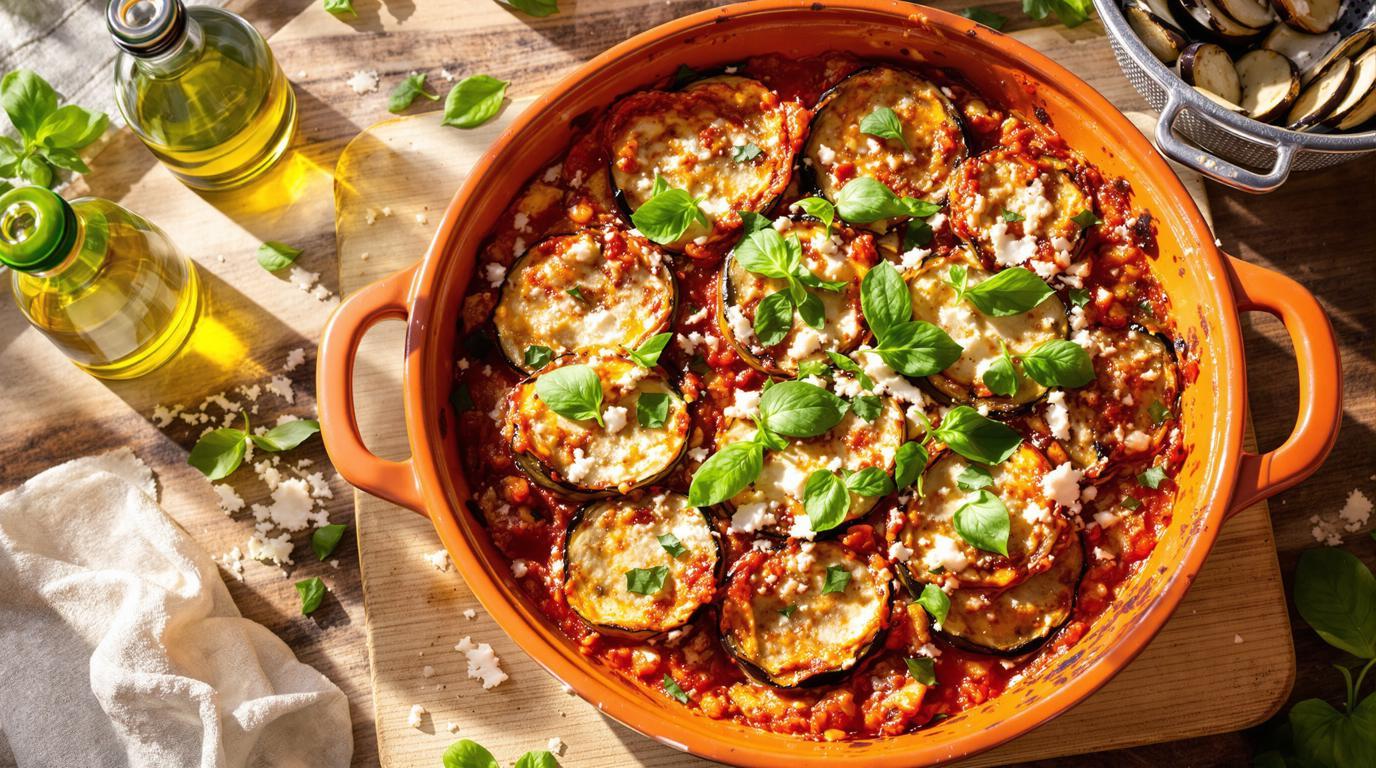Eggplant Parmigiana takes me back to my grandmother’s sunlit kitchen in southern Italy, where time seemed to slow as she transformed humble eggplants into something magical. I remember watching her weathered hands meticulously salt each slice, explaining that “patience makes the difference between soggy and sublime.” This dish isn’t native to Parma as many believe—it originated in Sicily and Naples, where cooks focused on the pure flavors of eggplant and aged Parmigiano Reggiano, without the Americanized breading and blanket of mozzarella that came later. The authentic version celebrates simplicity, allowing each ingredient to sing.
The Story Behind Traditional Eggplant Parmigiana 📖
This classic dish earned its name not from the northern Italian city of Parma, but from the star ingredient—Parmigiano Reggiano cheese. In the sun-drenched kitchens of southern Italy, grandmothers have been perfecting this layered masterpiece for generations, teaching their daughters the subtle art of properly preparing eggplant. When I apprenticed in Naples, my mentor Chef Giuseppe would say, “Anyone can cook eggplant, but only those with patience can make it transcendent.” His grandmother’s recipe, which I’m sharing today, skips modern shortcuts, focusing instead on coaxing maximum flavor from minimum ingredients.
Essential Ingredients 🧾
For authentic Eggplant Parmigiana, quality trumps quantity every time:
- 2 large eggplants (about 2½ lbs/1.1 kg)
- ½ cup (150g) kosher salt (for drawing moisture, not all consumed)
- 3 tablespoons (45ml) extra virgin olive oil
- 3 garlic cloves, finely minced
- 1 can (28 oz/800g) San Marzano tomatoes, crushed by hand
- 6 fresh basil leaves, torn
- ¾ cup (75g) freshly grated Parmigiano Reggiano
- 1 teaspoon (5g) sugar
- Fresh black pepper to taste
- Neutral oil for frying (peanut oil is traditional)
Chef’s Note: San Marzano tomatoes are worth seeking out for their sweet-acidic balance and minimal seeds. If unavailable, look for fire-roasted canned tomatoes or passata (strained tomatoes) from Italy.
Step-by-Step Instructions 📝
The perfect Eggplant Parmigiana requires attention to detail:
- Prepare the eggplant: Slice eggplants into ¼-inch rounds. Layer in a colander, sprinkling each layer generously with kosher salt. Place a heavy pot on top and let drain for 1 hour. This crucial step removes bitterness and excess moisture.
- Meanwhile, make the sauce: Gently warm olive oil in a saucepan over medium-low heat. Add minced garlic and cook until fragrant but not browned, about 30 seconds. Add crushed tomatoes, torn basil, sugar, and a pinch of salt and pepper. Simmer gently for 15-20 minutes until slightly thickened. The sauce should coat the back of a wooden spoon.
- Rinse and dry the eggplant: After draining, quickly rinse salt from eggplant slices and thoroughly pat dry with paper towels. Proper drying prevents dangerous oil splatter during frying.
- Fry the eggplant: Heat ½-inch of peanut oil in a heavy skillet to 350°F (175°C). Working in batches to avoid crowding, fry eggplant until golden brown on both sides, about 2-3 minutes per side. Transfer to paper towels to drain excess oil.
- Assemble the dish: In a 9×13-inch (23×33cm) baking dish, spread a thin layer of tomato sauce. Arrange a layer of fried eggplant, slightly overlapping slices. Top with sauce and a generous sprinkle of Parmigiano Reggiano. Repeat layers, finishing with sauce and cheese on top.
- Bake and rest: Bake at 375°F (190°C) for 20 minutes until bubbly and lightly browned. Allow to rest for at least 30 minutes before serving—though traditionalists insist on 2 hours for optimal flavor melding.
Chef’s Secret Techniques 🤫
The difference between good and extraordinary Eggplant Parmigiana lies in technique. When frying, maintain oil temperature by using a cooking thermometer—too hot and the eggplant burns, too cool and it absorbs excess oil. I learned from watching my grandmother test the oil with a wooden spoon handle; when tiny bubbles form around it, the oil is ready.
Never skip the salting step! This technique, called “degorging,” removes excess moisture and bitterness. My grandmother would say, “The eggplant must cry before it can sing in your dish.” For a lighter version, you can brush eggplant slices with olive oil and bake at 400°F (200°C) for 15 minutes per side, though purists might question this modern adaptation.
Traditional recipes never include mozzarella or breading, which were American additions. The purity of well-prepared eggplant, vibrant tomato sauce, and aged Parmigiano Reggiano creates a symphony of flavors that needs no embellishment.
Serving & Presentation Tips 🍽️
Serve Eggplant Parmigiana slightly warm or at room temperature—never piping hot—to appreciate the full flavor profile. A simple side of fresh fruit creates a beautiful contrast, while crusty bread is perfect for capturing every last drop of sauce.
This dish pairs beautifully with Chianti Classico or, for something unusual, try a chilled Vermentino. Follow your meal with a light dessert like Grandmother’s Chocolate Babka for a sweet finish.
Eggplant Parmigiana improves with time, making it ideal for preparing ahead. I often make this when expecting guests, allowing it to rest while I prepare Grandmother’s Mediterranean Soup as a starter.
For an impressive spread, serve alongside Authentic Satay Skewers or Grandmother’s Chicken Curry for a global feast.
Remember, cooking is a language of love passed through generations. When you prepare this dish, you’re not just following a recipe—you’re continuing a tradition that connects you to countless kitchens across time. Trust your instincts, respect the ingredients, and most importantly, cook with heart. Your eggplant parmigiana isn’t just food; it’s your legacy on a plate.
